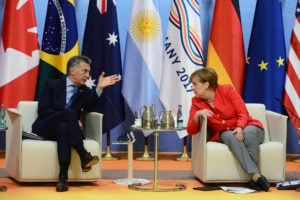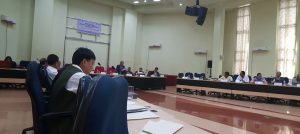Trillions of dollars. That is what India said it needed to deal with climate change in 2015. Where will this come from? Aid, grants and public finance for climate change adaptation and mitigation are not enough to even scratch the surface.
The only places in the world with trillions of dollars are global bond and equity markets – especially large pension funds in developed countries. Unfortunately, these markets are deeply invested in coal and oil. For some years, activists have been trying to move this money away from fossil fuels to renewable energy sources, but without much success.
Now, armed with the Paris Agreement, influential think tanks and some governments in western and northern Europe have got in on the act. Speaking on the condition of anonymity, a senior bureaucrat from one of these governments told thethirdpole.net that their job is tougher than turning the Titanic as the iceberg looms, but they are starting to succeed. The French government will try to make a big-ticket announcement along these lines next month, when President Emmanuel Macron hosts a meeting to mark two years of the Paris Agreement.
One precondition must be met before any significant headway is made; climate finances provided by the governments of rich countries to poorer nations must be enough to “de-risk” investments in clean energy and other green technologies. These public finances can never be enough for investments to solve the climate problem. But if finance pledges made at earlier global climate negotiations are kept, they can be enough to provide the all-important guarantees the bond and equity markets need.
Using market mechanisms to go green is increasingly popular. India has an INR 400 (USD 6.5) levy on every tonne of coal which has now led to a large pot available for green projects. China is integrating its state level emission trading schemes into a national market. California uses a combination of levies and trading schemes. So does Quebec. The relative failure of the European Union trading scheme had eclipsed these successes, but they are now showing up again.
Like aid and grants, this money is not enough to tackle climate change. Nevertheless, it can be used to “de-risk” green investments. As the Council for Energy, Environment and Water calculated, 75% of the cost of a solar energy project today is the cost of finance. If that cost is lowered by reducing interest rates through “de-risking”, we would be in a new era.
As UN Environment chief Erik Solheim told thethirdpole.net during COP23, “an environmental problem is solved when it becomes a business opportunity”.
The challenge is that bond markets – holding pension funds – are especially risk-averse. They need better guarantees for long-term stable growth before moving a significant portion of the USD 100 trillion they hold from fossil fuels to green energy or technologies.
Most governments are now aware of this and delegates from poorer countries were fighting hard during the UN climate summit to get as much public finance from rich countries as they could. They failed to get even an estimated amount, but they will keep trying.
Coal and oil lobbies see this as the biggest threat to their business interests, which is why the US government also fought hard to avoid making any commitments on finance. For the time being, it succeeded – though Macron made his displeasure clear saying on the penultimate day that trade wars can work in both directions.
Of course, money from funds controlled by the UNFCCC is not the only kitty. India’s solar market took off due to a bilateral agreement with the US (under Obama), when Exim Bank stood guarantee for a large loan for two solar farms. The market has grown and grown since then, though the problem of a high interest rate remains.
Policymakers and think tanks in developing countries believe the best way to tackle this is to get a predictable finance flow under the UNFCCC, apart from bilateral agreements. That is why they were so frustrated at the end of this year’s summit.
“They keep telling us we have to increase our ‘ambition’ to reduce GHG emissions and give the world a schedule for it. What about a schedule for the money they need to give us so that we can do all this?” a veteran negotiator from South Africa told thethirdpole.net, on the condition of anonymity.
Many observers said that raising ambition to act on climate change and raising the large amount of finance needed are so completely inter-connected that governments and the entire financial sector must see it as a single challenge.
Experts from UNEP and other organisations point out that every dollar invested in cutting GHG emissions and adapting to climate change gets double the bang for the buck because the results directly support the only sustainable future possible, which is captured in the international community’s 2030 agenda for sustainable development.
“The potential for climate friendly investment in areas such as clean energy and climate-smart agriculture is enormous. The key is to get the funding to flow so that everyone everywhere can benefit from low-carbon and climate resilient investments,” said Laura Tuck, vice president of sustainable development at the World Bank. “That’s why we are working with the UN and other development partners to create the conditions that will attract investors and to get all forms of finance – public, private, philanthropic – working together for maximum impact.”
Money for specific reasons
Even when more money becomes available, most of it will go towards renewable energy. That leaves the tougher problem of finding money for projects to adapt to climate change impacts. These projects are necessarily more dispersed and each one is relatively small, which increases the financial risk. That is one reason why the adaptation fund of the UNFCCC has been struggling. Now that the fund has been brought under the control of the Paris Agreement mechanism, it may see better days.
An even tougher problem – that some countries including the US, Japan and Australia refuse to discuss – is how to find public money to pay for the loss and damage being faced by countries due to climate change impacts. During this summit, developing countries demanded a permanent agenda item on loss and damage and an expert group on its financing, but only got a one-off expert dialogue. The move was described as a “damp squib” by Harjeet Singh, global lead on climate change for ActionAid International.
Many industrialised countries believe insurance is the only way to go to pay for loss and damage. “Insurance solutions can be a good and lasting possibility to create a buffer for risks,” German Chancellor Angela Merkel told the summit.
Insurance does work for fast-onset climate impacts such as floods and storms and to a certain extent for crop loss and livestock loss in a drought, but it is far less effective for slow-onset impacts such as sea level rise and ocean acidification.
Joint appeal from Rio conventions
Underlining the need for a truly enormous amount of money to heal the world, the heads all three UN conventions that emerged from the 1992 Rio Earth Summit – climate change, biodiversity and desertification – have asked for more finances to handle issues that are increasingly linked due to climate change and ill-planned development projects.
“We are calling for the establishment of a new project preparation facility to bridge this gap and promote an integrated, coherent and multi-disciplinary approach to these related issues while supporting the respective mandates of the three Rio Conventions,” they said during the summit.
“There is strong demand for a Rio Conventions Project Preparation Facility to help finance large-scale, transformative projects that deliver multiple benefits in addressing global challenges and achieving the sustainable development goals,” said Monique Barbut, executive secretary of the desertification convention.
The earth is facing multiple impacts, with land productivity declining at an alarming rate. More than a third of land is degraded, most of it over the last two decades. This has another serious consequence. Current management practices in the land-use sector are responsible for approximately 25% of global greenhouse gas (GHG) emissions. Biodiversity is disappearing at alarming rates well above natural rates. With more than 1.3 billion people reliant on degrading land and exposed to an unprecedented level of climate stress, the situation is expected to worsen.
The proposed facility would have two key functions: to deliver on existing commitments by promoting large-scale transformative projects to fill existing gaps between projects and funding, and to act as a catalyst for more coordinated action.
Officials in the three Rio conventions have repeatedly sought more collaboration, but face a problem – existing technical assistance facilities are sector-specific.
![<p>Patricia Espinosa, the executive secretary of the UNFCC, at COP23, second from left [image by: Climate Alliance]</p>](https://dialogue.earth/content/uploads/2017/11/38401189286_0c7f51d7e7_k.jpg)








